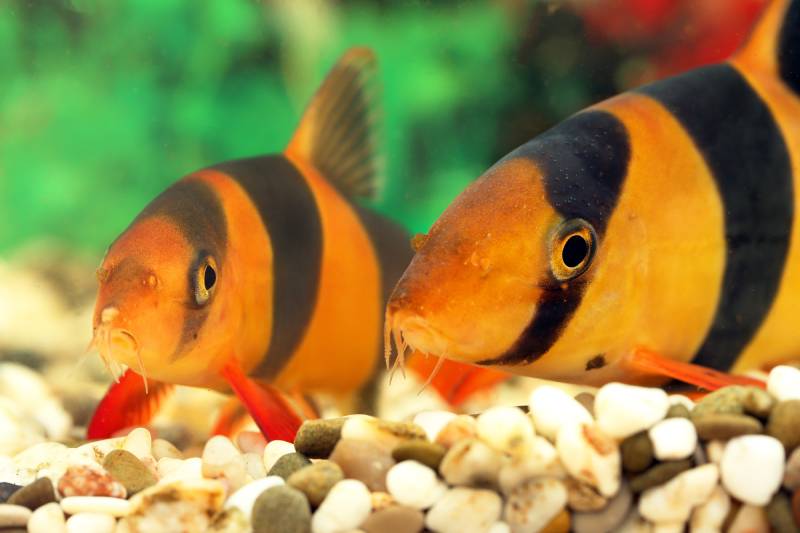
The Clown Loach (Chromobotia macracanthus) is a colorful freshwater fish and the only member in the Chromobotia genus. They are highly social fishes with fascinating behaviors which liven up most aquariums. You can recognize Clown Loaches by their orange and black patterns which have earned them the nickname “Tiger Botia.”
Breed Overview
| Size: | Up to 12 inches long |
| Lifespan: | 10–20 years |
| Similar Breeds: | Yoyo Loach, Golden Zebra Loach, and Polka Dot Loach |
| Suitable for: | Intermediate to experienced fish keepers |
| Temperament: | Social, active, timid, and peaceful |
Clown Loaches are tropical fish that are often kept in community aquariums. Their peaceful and social temperament makes them compatible with many tank mates, and they rarely show signs of aggression. Clown Loaches do a great job at tidying up the aquarium by eating any leftover food and detritus that would otherwise contribute to water quality issues.
If you are considering adding an active and colorful Clown Loach to your aquarium, this article will help you decide if they are the right fish for you.
Clown Loach Characteristics

How Much Do Clown Loaches Cost?
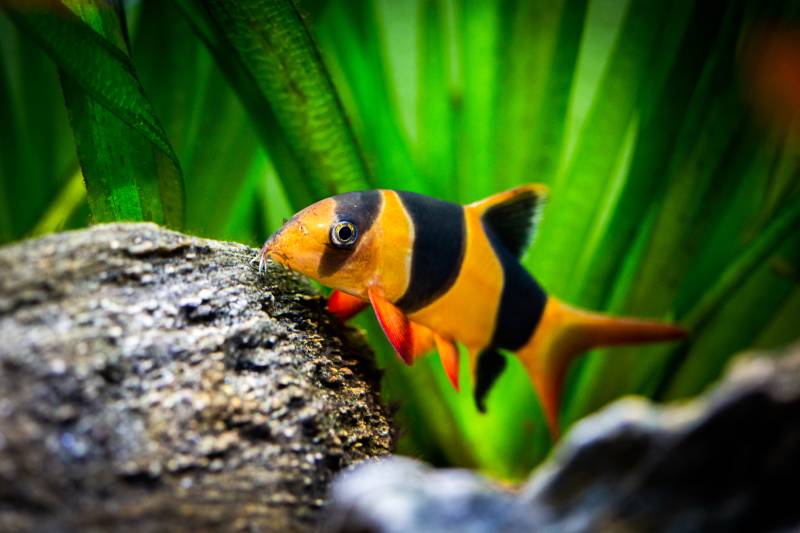
Clown Loaches originate from Indonesia and Malaysia where they inhabit the slow-moving waterways like acidic streams. They were first described in 1852 by Dr. Pieter Bleeker, but it wasn’t until 2004 that they got classified into their genus. Clown Loaches have been in the aquarium trade industry for decades and make popular additions to very large tropical tanks. They are not considered rare and can be found for sale at most pet stores, fish breeders, and online retailers. Clown Loaches generally cost between $10 to $30 for one fish, but you can often get them at a discounted price if you purchase them in groups.
Sociability of the Clown Loach
Do These Fish Make Good Pets?
Many people purchase Clown Loaches without truly knowing what their care entails. They might be unaware of the Clown Loaches’ size and social requirements, so they are not prepared for how demanding Clown Loaches can be as pets. Although Clown Loaches do make good pets when cared for properly, their care might be more difficult than some new fish keepers can handle.
Clown Loaches are often sold at a small size in pet stores, where fish keepers might choose them for a small aquarium. However, the Clown Loach can grow up to 12 inches long in captivity, and up to 18 inches in the wild. Clown Loaches are also naturally social animals that need to be kept in groups of five or more.
You should never keep Clown Loaches on their own or in pairs since they can be incredibly stressful for them. With the Clown Loach being a large fish and needing to be kept in large groups, their tank needs to be over 100 gallons in size.
Unfortunately, not everyone has space for a 100-gallon or larger fish tank in their home, nor the time and money to maintain one. It is very important to keep in mind that Clown Loaches only make good pets for those who can keep them in groups and in very large, heated, and maintained aquariums.
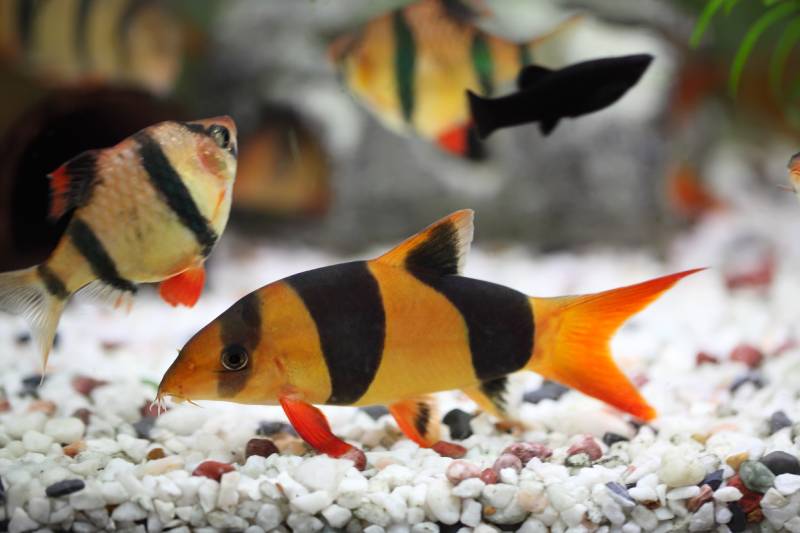
Does This Fish Make a Good Tankmate?
Clown Loaches are very peaceful and make good tankmates for other compatible fish or invertebrates. This is one of the main reasons that make good additions to large community aquariums if the conditions are right. However, the best tankmates for a Clown Loach are their species. They need to be kept in groups of five or more before being kept with other tankmates.
Their tank needs to be upgraded accordingly each time new tankmates are added. The size of a Clown Loach community tank can vary depending on the species, size, and the number of tankmates.
Aside from their species, the following fish can make good tankmates for Clown Loaches:
You ideally want to keep Clown Loaches with other tropical and freshwater fish that grow larger than 2 inches long. Their tank mates should thrive in the same water conditions as Clown Loaches and eat a similar diet. Tankmates like snails, shrimp, goldfish, and aggressive fish are not compatible tankmates for Clown Loaches and should be avoided.

Care Guide & Tank Set Up
Clown Loaches should only be housed in rectangular aquariums and not bowls, vases, or nano aquariums. A 100-gallon long tank can comfortably house a group of six Clown Loaches and a couple of small tankmates. Keep in mind that the larger the Clown Loaches get, the larger the tank needs to be. Horizontal swimming space is preferred as Clown Loaches are bottom-dwelling fish that actively swim and explore their environment.
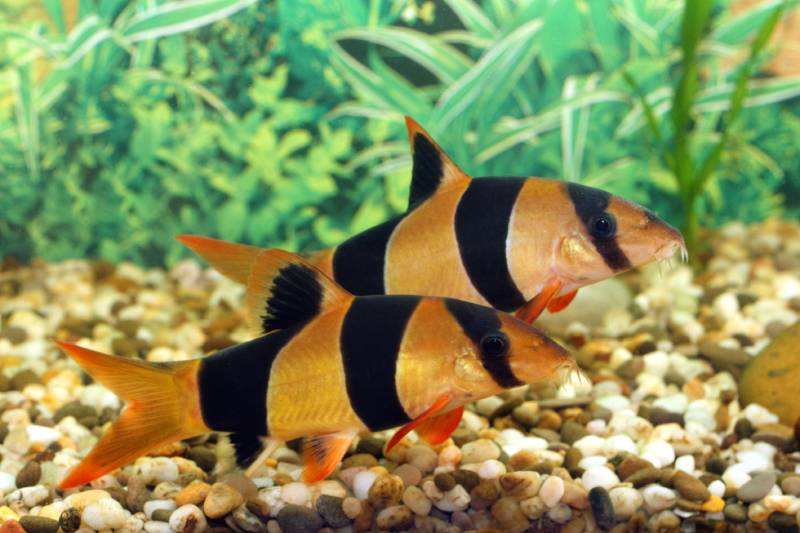
Water Quality, pH & Temperature
The Clown Loach’s aquarium should replicate the water conditions and setup they experience in the wild. Their wild habitat consists of murky streams with a slightly acidic to neutral pH range. It is important to keep your Clown Loach tank heated because they experience tropical temperatures in the wild. They thrive at temperatures between 75 to 86 degrees Fahrenheit, with few drastic fluctuations. A 1–2 degree drop throughout the day is not much of a concern.
Like most aquarium fish, the Clown Loaches aquarium needs to undergo the nitrogen cycle for 4 to 6 weeks before adding them in. Clown Loaches are very sensitive to even the slightest traces of ammonia or nitrite, so the safest level is 0 ppm (parts per million).
| Temperature: | 75° to 86° Fahrenheit (23° to 30° Celsius) |
| Hardness: | 5 to 12 dH |
| pH: | 5.0 to 7.0 |
| Ammonia: | 0 ppm |
| Nitrite: | 0 ppm |
| Nitrate: | Below 15 ppm |
Substrate
Clown Loaches typically prefer to glide across the substrate as they swim, so choosing the right substrate for them is crucial. The underside of a Clown Loach is not protected and can easily get injured by sharp substrate.
In their wild habitat, Clown Loaches dwell along a sandy and muddy substrate. This is why sandy substrates or very fine quartz gravel is preferred for Clown Loaches. Clown Loaches will forage throughout fine substrates in search of food using their barbels, which is difficult in gravel or pebble substrates. You ideally want to choose substrates with a natural coloration like brown, black, or tan rather than brightly colored substrates.
Plants
Live plants are recommended for Clown Loaches for numerous reasons, like water purification, shelter, and oxygenation. Their wild habitat is filled with rocks, leaf litter, and tree roots which provides Clown Loaches with plenty of shelter to make them feel safe. Clown Loaches will appreciate having a moderately planted tank with hornwort, Amazon sword, anubias, and jungle vals.
You can also add aquarium-safe driftwood as a centerpiece in the aquarium. The tannins that leach from the driftwood are not harmful and give the water a natural tea color similar to the Clown Loaches’ wild habitat.
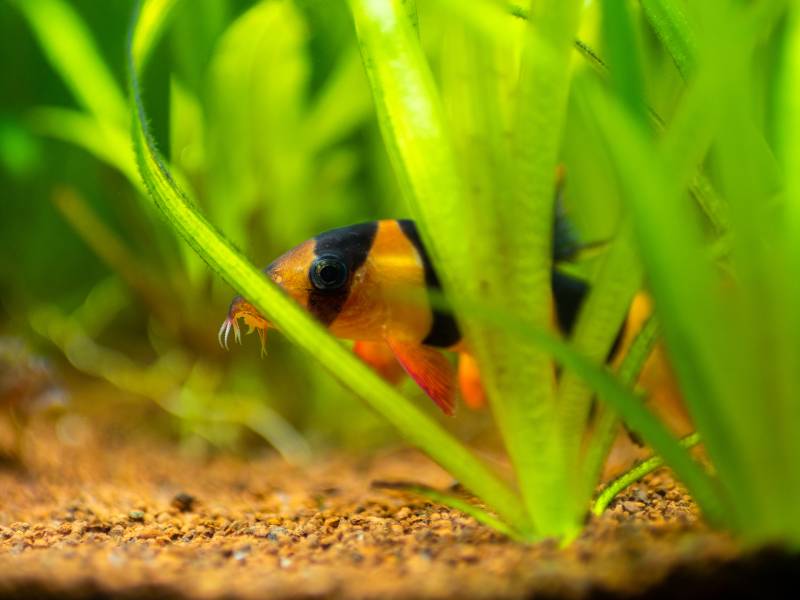
Lighting
Clown Loaches require a low to moderately bright aquarium. Unlike most loaches, the Clown Loach is a diurnal fish that is awake during the day and rests at night. They are used to the low-lit conditions caused by murky water and trees that shade their native habitats. Their aquarium lighting should only be on for 6 to 10 hours per day and switched off at night. Clown Loaches need to rest for at least 8 hours at night in complete darkness. Keeping their aquarium lit 24/7 can cause issues with their circadian rhythm and contribute to excessive algae growth.
Filtration
Filters are a necessity for Clown Loach aquariums and help keep the water clean and moving. The size of the filter will depend on the size of your Clown Loaches tank but should not create much of a current in the water. Clown Loaches prefer slow-moving waters and do not enjoy swimming against fast currents. This could tire them out and cause them unnecessary stress. However, the filter should create enough surface agitation to oxygenate the water if you are not using an aeration system.
Large sponge filters are usually a top choice for Clown Loach aquariums, but under-gravel and external filters work well too.

Things to Know When Owning a Clown Loach
Food & Diet Requirements
Clown Loaches are omnivores that eat a diet consisting of various plant and animal-based foods. However, they prefer to follow a more carnivorous diet in the wild. They naturally feed on mollusks, insects, crustaceans, and worms, but will eat vegetation if they are hungry enough.
Their captive diet should consist of a commercial sinking pellet or flake food that is formulated for loaches. This will be their staple food and should be offered once or twice a day. You can supplement your Clown Loaches diet with bloodworms, daphnia, shrimp, and small snails occasionally.
Most Clown Loaches aren’t fussy about what they eat and will even eat another fish. Keep in mind that as bottom dwellers, Clown Loaches prefer to eat their food from the substrate. They struggle to eat food that floats on the surface.
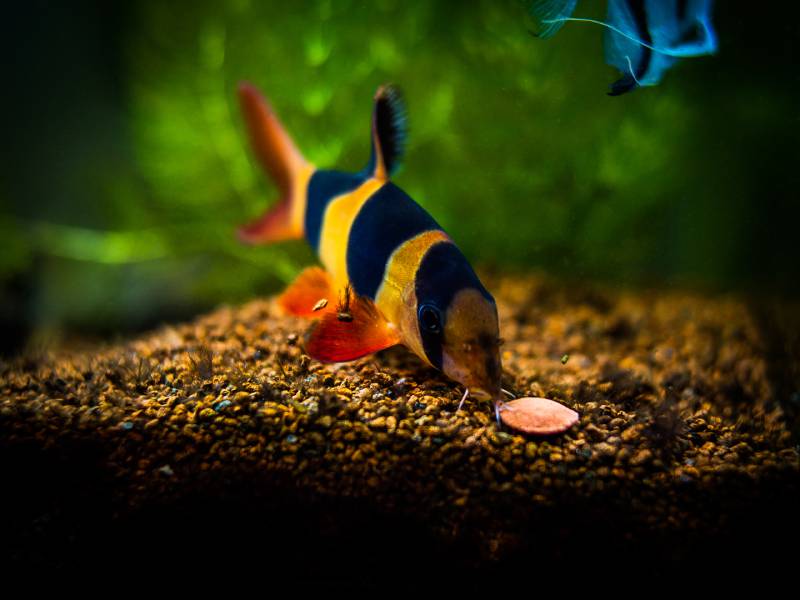
Size & Growth Rate
Clown Loaches are surprisingly large fish, unbeknownst to many fish keepers. Their average adult size is between 10 to 12 inches long in captivity, but up to 18 inches in the wild. Clown Loaches that are raised for food in the Indonesian islands have been known to reach 16 inches in length. They have a moderately fast growth rate when kept in the right conditions.
They do most of their growth within the first 4 to 6 years of their life. Their growth starts to slow down at around 7 years, and they usually reach their full adult size at 10 years. Clown Loaches need a very large tank, proper water conditions, a healthy diet, and pristine water quality to support their growth.
Varieties
Clown Loaches have a distinctive orange and black patterned body with red fins which resembles a clown suit. Their caudal (tail) fins are forked, and their small mouths are lined with tiny barbels. Clown Loaches have small triangular dorsal fins and have a more elongated body to support their bottom-dwelling behaviors. They have black V-shaped markings along their bodies which can look uneven in some Clown Loaches. Clown Loaches are only available in one variety, but there have been a few instances where they were found with white V-shaped markings instead of black.
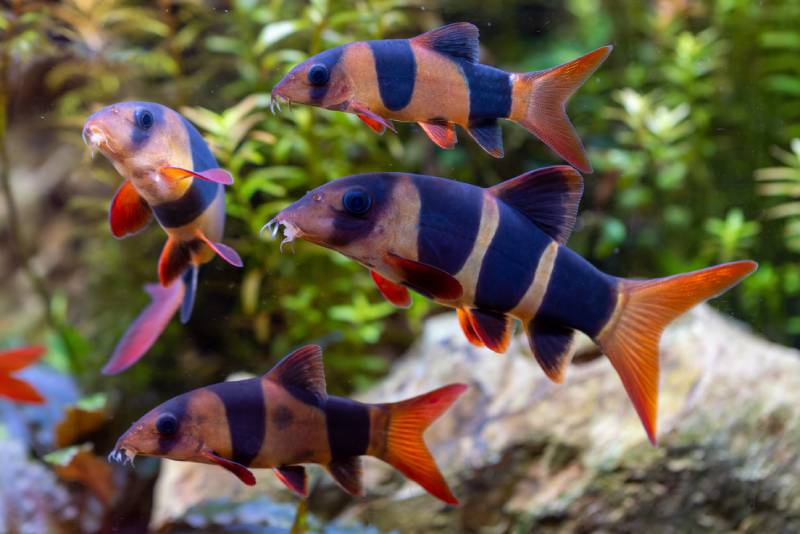
Lifespan and Health Conditions
Clown Loaches have a lengthy lifespan of 10 to 20 years as pets, but even longer in the wild or with proper care. Unfortunately, many Clown Loaches do not live very long in captivity. Improper water conditions, housing, diet, and diseases are to blame for their early deaths. Clown Loaches are susceptible to the same health as most tropical and freshwater fish.
These conditions include:
Minor Conditions
Serious Conditions
Their most common health conditions include ammonia and nitrite toxicity from poor water quality, along with various skin issues like ich or velvet.
Male vs Female
Clown Loaches are sexually dimorphic fish, so males and females can be told apart by their appearance.
| Male Clown Loach: | Female Clown Loach: |
| Slender body shape. | Plump and rounded body shape. |
| Pointier fins. | More rounded fins. |
| Slightly smaller. | Larger and heavier. |
| Longer and inward-facing caudal fin. | Shorter caudal fin. |

3 Little-Known Facts About Clown Loaches
1. Clown Loaches can make audible clicking sounds
Clown Loaches have been known to make a faint clicking sound by grinding their pharyngeal teeth. This sound can be heard when a Clown Loach is feeling happy or threatened, and sometimes during mating. Clicking sounds helps them communicate with each other often to defend their territory from other fish.
2. Clown Loaches can live for up to 30 years
The average lifespan for Clown Loaches is between 10 to 20 years. However, they have been known to live for up to 30 years, similar to ornamental goldfish and koi. Caring for a Clown Loach can be a 2-to-3-decade commitment, so be prepared to have them around for a long time.
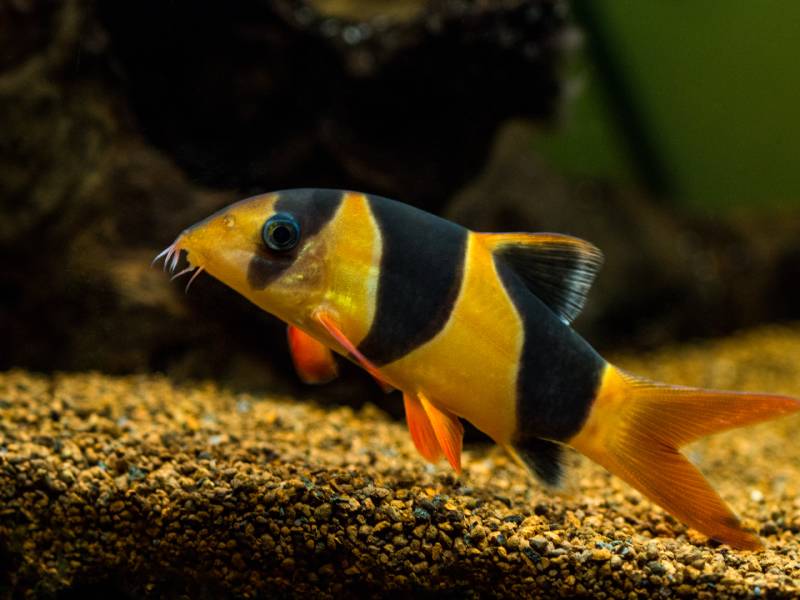
3. There is a common misconception that Clown Loaches do not have any scales, which is not true
Clown Loaches have tiny scales embedded into their skin, although they are not normal scales. However, Clown Loaches are still sensitive to certain medications and are highly susceptible to skin issues.

Final Thoughts
Caring for Clown Loaches is a rewarding experience and fairly simple if you understand their care requirements. Clown Loaches can reach 12 inches in length in captivity and therefore require very large aquariums.
A group of six Clown Loaches should be kept in no less than 100 gallons of water and only with compatible tank mates. They are sensitive to poor water quality, so their tank needs to be regularly maintained and fully cycled before they are added in. Most Clown Loaches can have a longer commitment than most dogs and cats.
You will need to determine if you are prepared to care for a very large fish with demanding tank size requirements and a lengthy lifespan before purchasing a Clown Loach.
Featured Image Credit: Grigorii Pisotsckii, Shutterstock
